Tang Dynasty

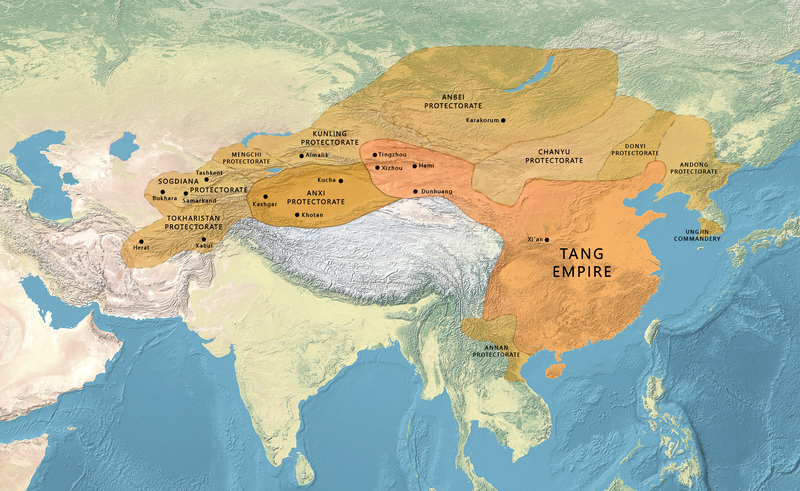
It was preceded by the Sui dynasty ( 隋朝 ) and followed by the Five Dynasties and Ten Kingdoms ( 五代十国 ) period. Historians generally regard the Tang as a high point in Chinese civilization, and a golden age of cosmopolitan culture. Tang territory, acquired through the military campaigns of its early rulers, rivaled that of the Han dynasty ( 汉朝 ).
The Tang capital at Chang'an ( present-day Xi'an - 西安 ) was the world's most populous city for much of the dynasty's existence. Two censuses of the 7th and 8th centuries estimated the empire's population at about 50 million people, which grew to an estimated 80 million by the dynasty's end. From its numerous subjects, the dynasty raised professional and conscripted armies of hundreds of thousands of troops to contend with nomadic powers for control of Inner Asia and the lucrative trade-routes along the Silk Road ( 丝绸之路 ). Far-flung kingdoms and states paid tribute to the Tang court, while the Tang also indirectly controlled several regions through a protectorate system. In addition to its political hegemony, the Tang exerted a powerful cultural influence over neighboring East Asian nations such as Japan and Korea.
Chinese culture flourished and further matured during the Tang era. It is traditionally considered the greatest age for Chinese poetry. Two of China's most famous poets, Li Bai ( 李白 ) and Du Fu ( 杜甫 ), belonged to this age, contributing with poets such as Wang Wei to the monumental Three Hundred Tang Poems. Many famous painters such as Han Gan, Zhang Xuan, and Zhou Fang were active, while Chinese court music flourished with instruments such as the popular pipa. Tang scholars compiled a rich variety of historical literature, as well as encyclopedias and geographical works. Notable innovations included the development of woodblock printing. Buddhism became a major influence in Chinese culture, with native Chinese sects gaining prominence.
Tang Dynasty History
Establishment
The Li family had ethnic Han origins, and it belonged to the northwest military aristocracy prevalent during the Sui dynasty. According to official Tang records, they were paternally descended from Laozi, the traditional founder of Taoism (whose personal name was Li Dan or Li Er), the Han dynasty general Li Guang, and Li Gao, the founder of the Han-ruled Western Liang kingdom. This family was known as the Longxi Li lineage, and it included the prominent Tang poet Li Bai. Aside from traditional historiography, some modern historians have suggested that the Tang imperial family might have modified its genealogy to conceal Xianbei heritage. The Tang emperors had part-Xianbei maternal ancestry, from Emperor Gaozu of Tang's part-Xianbei mother, Duchess Dugu.
Li Yuan ( 李渊 ), the founder of the Tang dynasty, was Duke of Tang and governor of Taiyuan, the capital of modern Shanxi, during the collapse of the Sui dynasty. He had prestige and military experience, and was a first cousin of Emperor Yang of Sui (their mothers were both one of the Dugu sisters). Li Yuan rose in rebellion in 617, along with his son and his equally militant daughter Princess Pingyang (d. 623), who raised and commanded her own troops. In winter 617, Li Yuan occupied Chang'an, relegated Emperor Yang to the position of Taishang Huang or retired emperor, and acted as regent to the puppet child-emperor, Yang You. On the news of Emperor Yang's murder by General Yuwen Huaji ( Chinese: 宇文化及; died March 22, 619 ) on June 18, 618, Li Yuan declared himself the emperor of a new dynasty, the Tang.
Li Yuan, known as Emperor Gaozu of Tang, ruled until 626, when he was forcefully deposed by his son Li Shimin, the Prince of Qin. Li Shimin had commanded troops since the age of 18 years old, had prowess with bow and arrow, sword and lance and was known for his effective cavalry charges. Fighting a numerically superior army, he defeated Dou Jiande (573–621) at Luoyang in the Battle of Hulao on May 28, 621. Due to fear of assassination, Li Shimin ambushed and killed two of his brothers, Li Yuanji (b. 603) and crown prince Li Jiancheng (b. 589), in the Xuanwu Gate Incident on July 2, 626. Shortly thereafter, his father abdicated in his favor and Li Shimin ascended the throne. He is conventionally known by his temple name Taizong.
Although killing two brothers and deposing his father contradicted the Confucian value of filial piety, Taizong showed himself to be a capable leader who listened to the advice of the wisest members of his council. In 628, Emperor Taizong held a Buddhist memorial service for the casualties of war, and in 629 he had Buddhist monasteries erected at the sites of major battles so that monks could pray for the fallen on both sides of the fight.
During the Tang campaign against the Eastern Turks, the Eastern Turkic Khaganate was destroyed after the capture of its ruler, Illig Qaghan by the famed Tang military officer Li Jing (571–649), who later became a Chancellor of the Tang dynasty. With this victory, the Turks accepted Taizong as their khagan, a title rendered as Tian Kehan in addition to his rule as emperor of China under the traditional title "Son of Heaven". Taizong was succeeded by his son Li Zhi (as Emperor Gaozong) in 649 CE.
The Tang dynasty further led the Tang campaigns against the Western Turks. Early military conflicts were a result of the Tang interventions in the rivalry between the Western and Eastern Turks in order to weaken both. Under Emperor Taizong, campaigns were dispatched in the Western Regions against Gaochang in 640, Karasahr in 644 and 648, and Kucha in 648. The wars against the Western Turks continued under Emperor Gaozong, and the Western Turkic Khaganate was finally annexed after General Su Dingfang's defeat of Qaghan Ashina Helu in 657 CE.
Wu Zetian's usurpation
Although she entered Emperor Gaozong's court as the lowly consort, Wu Zetian rose to the highest seat of power in 690, establishing the short-lived Wu Zhou. Empress Wu's rise to power was achieved through cruel and calculating tactics: a popular conspiracy theory stated that she killed her own baby girl and blamed it on Gaozong's empress so that the empress would be demoted. Emperor Gaozong suffered a stroke in 655, and Wu began to make many of his court decisions for him, discussing affairs of state with his councilors, who took orders from her while she sat behind a screen. When Empress Wu's eldest son, the crown prince, began to assert his authority and advocate policies opposed by Empress Wu, he suddenly died in 675. Many suspected he was poisoned by Empress Wu. Although the next heir apparent kept a lower profile, in 680 he was accused by Wu of plotting a rebellion. He was then banished and later obliged to commit suicide.
In 683, Emperor Gaozong died. He was succeeded by Emperor Zhongzong, his eldest surviving son by Wu. Zhongzong tried to appoint his wife's father as chancellor: after only six weeks on the throne, he was deposed by Empress Wu in favor of his younger brother, Emperor Ruizong. This provoked a group of Tang princes to rebel in 684. Wu's armies suppressed them within two months. She proclaimed the Tianshou era of Wu Zhou on October 16, 690, and three days later demoted Emperor Ruizong to crown prince. He was also forced to give up his father's surname Li in favor of the Empress Wu. She then ruled as China's only empress regnant.
Model of Luoyang imperial palace during Wu Zetian's reign. Many major construction projects were commissioned during Wu Zetian's time, such as the Bright Hall [zh] of Luoyang (right) commissioned by Wu Zetian (original 294 chi = 93m tall).
A palace coup on February 20, 705, forced Empress Wu to yield her position on February 22. The next day, her son Zhongzong was restored to power; the Tang was formally restored on March 3. She died soon after. To legitimize her rule, she circulated a document known as the Great Cloud Sutra, which predicted that a reincarnation of the Maitreya Buddha would be a female monarch who would dispel illness, worry, and disaster from the world. She even introduced numerous revised written characters to the language, though they reverted to the original forms after her death. Arguably the most important part of her legacy was diminishing the hegemony of the Northwestern aristocracy, allowing people from other clans and regions of China to become more represented in Chinese politics and government.
Emperor Xuanzong's reign
There were many prominent women at court during and after Wu's reign, including Shangguan Wan'er (664–710), a poet, writer, and trusted official in charge of Wu's private office. In 706 the wife of Emperor Zhongzong of Tang, Empress Wei (d. 710), persuaded her husband to staff government offices with his sister and her daughters, and in 709 requested that he grant women the right to bequeath hereditary privileges to their sons (which before was a male right only). Empress Wei eventually poisoned Zhongzong, whereupon she placed his fifteen-year-old son upon the throne in 710. Two weeks later, Li Longji (the later Emperor Xuanzong) entered the palace with a few followers and slew Empress Wei and her faction. He then installed his father Emperor Ruizong (r. 710–712) on the throne. Just as Emperor Zhongzong was dominated by Empress Wei, so too was Ruizong dominated by Princess Taiping. This was finally ended when Princess Taiping's coup failed in 712 (she later hanged herself in 713) and Emperor Ruizong abdicated to Emperor Xuanzong.
During the 44-year reign of Emperor Xuanzong, the Tang dynasty reached its height, a golden age with low economic inflation and a toned down lifestyle for the imperial court. Seen as a progressive and benevolent ruler, Xuanzong even abolished the death penalty in the year 747; all executions had to be approved beforehand by the emperor himself (these were relatively few, considering that there were only 24 executions in the year 730). Xuanzong bowed to the consensus of his ministers on policy decisions and made efforts to staff government ministries fairly with different political factions. His staunch Confucian chancellor Zhang Jiuling (673–740) worked to reduce deflation and increase the money supply by upholding the use of private coinage, while his aristocratic and technocratic successor Li Linfu (d. 753) favored government monopoly over the issuance of coinage. After 737, most of Xuanzong's confidence rested in his long-standing chancellor Li Linfu, who championed a more aggressive foreign policy employing non-Chinese generals. This policy ultimately created the conditions for a massive rebellion against Xuanzong.
An Lushan Rebellion and catastrophe
The Tang Empire was at its height of power up until the middle of the 8th century, when the An Lushan Rebellion ( 安史之乱 - December 16, 755 – February 17, 763 ) destroyed the prosperity of the empire. An Lushan was a half-Sogdian, half-Turk Tang commander since 744, who had experience fighting the Khitans of Manchuria with a victory in 744, yet most of his campaigns against the Khitans were unsuccessful. He was given great responsibility in Hebei, which allowed him to rebel with an army of more than 100,000 troops. After capturing Luoyang, he named himself emperor of a new, but short-lived, Yan state. Despite early victories scored by Tang General Guo Ziyi (697–781), the newly recruited troops of the army at the capital were no match for An Lushan's frontier veterans, so the court fled Chang'an. While the heir apparent raised troops in Shanxi and Xuanzong fled to Sichuan province, they called upon the help of the Uyghur Khaganate in 756. The Uyghur khan Moyanchur was greatly excited at this prospect, and married his own daughter to the Chinese diplomatic envoy once he arrived, receiving in turn a Chinese princess as his bride. The Uyghurs helped recapture the Tang capital from the rebels, but they refused to leave until the Tang paid them an enormous sum of tribute in silk. Even Abbasid Arabs assisted the Tang in putting down An Lushan's rebellion. A massacre of foreign Arab and Persian Muslim merchants by Tian Shengong happened during the An Lushan rebellion in the Yangzhou massacre (760). The Tibetans took hold of the opportunity and raided many areas under Chinese control, and even after the Tibetan Empire had fallen apart in 842 (and the Uyghurs soon after) the Tang were in no position to reconquer Central Asia after 763. So significant was this loss that half a century later jinshi examination candidates were required to write an essay on the causes of the Tang's decline. Although An Lushan was killed by one of his eunuchs in 757, this time of troubles and widespread insurrection continued until rebel Shi Siming was killed by his own son in 763.
The Leshan Giant Buddha, 71 m (233 ft) high; begun in 713, completed in 803Nanchan Temple (Wutai), built during the late 8th century.
One of the legacies that the Tang government left since 710 was the gradual rise of regional military governors, the jiedushi ( 节度使 ), who slowly came to challenge the power of the central government. After the An Lushan Rebellion, the autonomous power and authority accumulated by the jiedushi in Hebei went beyond the central government's control. After a series of rebellions between 781 and 784 in today's Hebei, Shandong, Hubei and Henan provinces, the government had to officially acknowledge the jiedushi's hereditary rule without accreditation. The Tang government relied on these governors and their armies for protection and to suppress locals that would take up arms against the government. In return, the central government would acknowledge the rights of these governors to maintain their army, collect taxes and even to pass on their title to heirs. As time passed, these military governors slowly phased out the prominence of civil officials drafted by exams, and became more autonomous from central authority. The rule of these powerful military governors lasted until 960, when a new civil order under the Song dynasty was established. Also, the abandonment of the equal-field system meant that people could buy and sell land freely. Many poor fell into debt because of this, forced to sell their land to the wealthy, which led to the exponential growth of large estates. With the breakdown of the land allocation system after 755, the central Chinese state barely interfered in agricultural management and acted merely as tax collector for roughly a millennium, save a few instances such as the Song's failed land nationalization during the 13th-century war with the Mongols.
With the central government collapsing in authority over the various regions of the empire, it was recorded in 845 that bandits and river pirates in parties of 100 or more began plundering settlements along the Yangtze River with little resistance. In 858, massive floods along the Grand Canal inundated vast tracts of land and terrain of the North China Plain, which drowned tens of thousands of people in the process. The Chinese belief in the Mandate of Heaven granted to the ailing Tang was also challenged when natural calamities occurred, forcing many to believe that the Tang had lost their right to rule. Furthermore, in 873 a disastrous harvest shook the foundations of the empire; in some areas only half of all agricultural produce was gathered, and tens of thousands faced famine and starvation. In the earlier period of the Tang, the central government was able to meet crises in the harvest, as it was recorded from 714 to 719 that the Tang government responded effectively to natural disasters by extending the price-regulation granary system throughout the country. The central government was able then to build a large surplus stock of foods to ward off the rising danger of famine and increased agricultural productivity through land reclamation. In the 9th century, however, the Tang government was nearly helpless in dealing with any calamity.
Emperors of the Tang dynasty
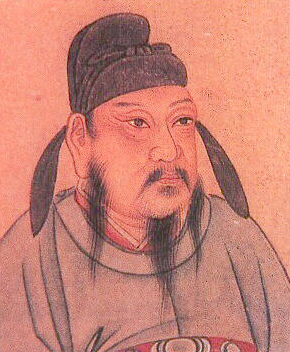
Temple name
Gaozu 高祖
-
Personal name
Li Yuan 李渊 -
Reigned
18 June 618 - 4 September 626 abdicated -
Posthumous name
Emperor Shenyao 神堯皇帝 -
Era name and years
Wude (武德) 618–626
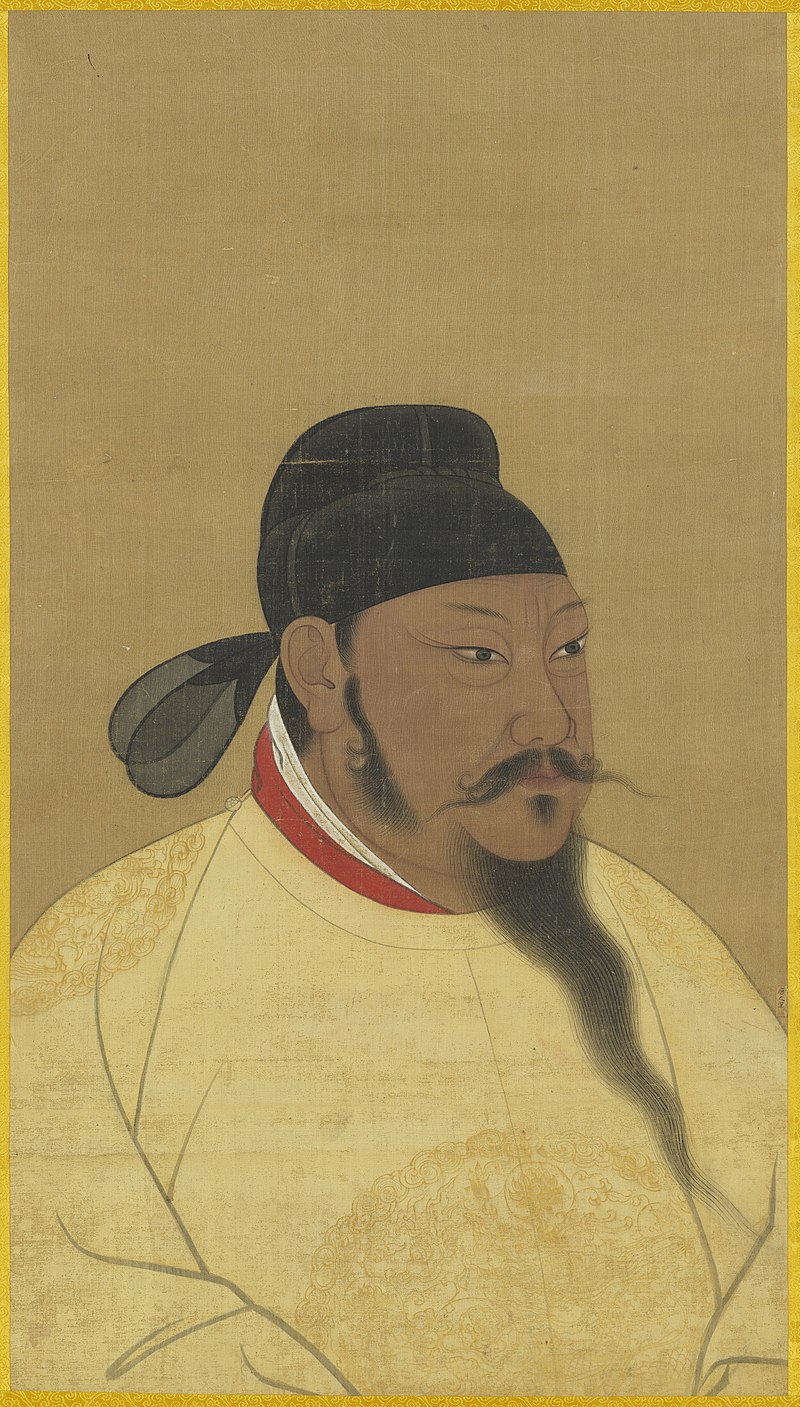
Temple name
Taizong 太宗
-
Personal name
Li Shimin 李世民 -
Reigned
4 September 626 - 10 July 649 -
Posthumous name
Emperor Wenwu 文武皇帝 -
Era name and years
Zhenguan (贞观) 627–649
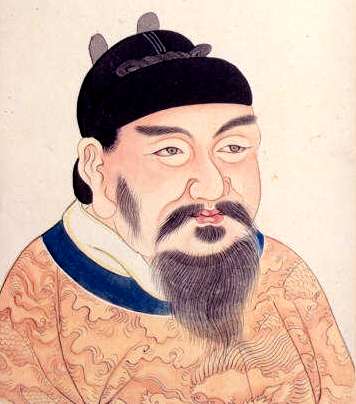
Temple name
Gaozong 高宗
-
Personal name
Li Zhi 李治 -
Reigned
15 July 649 - 27 December 683 -
Posthumous name
Emperor Tianhuang 天皇大帝 -
Era name and years
Yonghui (永徽) 650–655
Xianqing (顯慶) 656–661
Longshuo (龍朔) 661–663
Linde (麟德) 664–665
Qianfeng (乾封) 666–668
Zongzhang (總章) 668–670
Xianheng (咸亨) 670–674
Shangyuan (上元) 674–676
Yifeng (儀鳳) 676–679
Tiaolu (調露) 679–680
Yonglong (永隆) 680–681
Kaiyao (開耀) 681–682
Yongchun (永淳) 682–683
Hongdao (弘道) 683
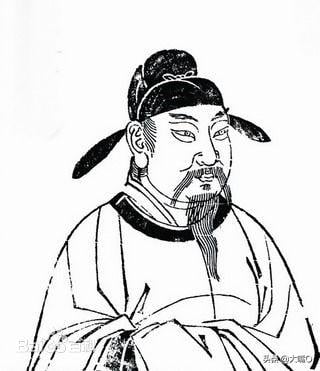
Temple name
Zhongzong 中宗
-
Personal name
Li Xian 李显 -
Reigned
3 January 684 - 26 February 684 deposed
23 February 705 - 3 July 710 -
Posthumous name
Emperor Xiaohe 孝和皇帝 -
Era name and years
Sisheng (嗣聖) 23 January–27 February 684
Shenlong (神龍) 705–707
Jinglong (景龍) 707–710
Military and Foreign Policy of Tang Dynasty
Protectorates and tributaries
The 7th and first half of the 8th century are generally considered to be the era in which the Tang reached the zenith of its power. In this period, Tang control extended further west than any previous dynasty, stretching from north Vietnam in the south, to a point north of Kashmir bordering Persia in the west, to northern Korea in the north-east.
Some of the kingdoms paying tribute to the Tang dynasty included Kashmir, Nepal, Khotan, Kucha, Kashgar, Silla, Champa, and kingdoms located in Amu Darya and Syr Darya valley. Turkic nomads addressed the Emperor of Tang China as Tian Kehan. After the widespread Göktürk revolt of Shabolüe Khan (d. 658) was put down at Issyk Kul in 657 by Su Dingfang (591–667), Emperor Gaozong established several protectorates governed by a Protectorate General or Grand Protectorate General, which extended the Chinese sphere of influence as far as Herat in Western Afghanistan. Protectorate Generals were given a great deal of autonomy to handle local crises without waiting for central admission. After Xuanzong's reign, jiedushi were given enormous power, including the ability to maintain their own armies, collect taxes, and pass their titles on hereditarily. This is commonly recognized as the beginning of the fall of Tang's central government.
Soldiers and conscription
By the year 737, Emperor Xuanzong discarded the policy of conscripting soldiers that were replaced every three years, replacing them with long-service soldiers who were more battle-hardened and efficient. It was more economically feasible as well, since training new recruits and sending them out to the frontier every three years drained the treasury. By the late 7th century, the fubing troops began abandoning military service and the homes provided to them in the equal-field system. The supposed standard of 100 mu of land allotted to each family was in fact decreasing in size in places where population expanded and the wealthy bought up most of the land. Hard-pressed peasants and vagrants were then induced into military service with benefits of exemption from both taxation and corvée labor service, as well as provisions for farmland and dwellings for dependents who accompanied soldiers on the frontier. By the year 742 the total number of enlisted troops in the Tang armies had risen to about 500,000 men.
Tang Dynasty Culture
Art in the Tang Dynasty
During the Tang Dynasty, emphasis was made in developing art. The Tang era was an age of figure painters who created new styles of ceramics that were bold and colorful with variegated glazes.
Potters developed new techniques that included the use of “sancai,” which is a type of decoration that used three colors that mixed together for a unique look. Decorated bronze mirrors and white porcelain were also famous at that time as were sculptures of Buddha.
Poetry in the Tang Dynasty
The Tang era was a golden period for poetry and art. It is during this time that poetry became an integral part of the Chinese culture. The open policies of the Tang dynasty attracted people from many foreign lands to China, bringing various cultural elements into the society.
During the Tang Dynasty, one of the most distinguished cultural achievements came in form of Tang poems. A number of excellent poets appeared during the Tang era. Themes of their poems were varied, including life in peaceful village fields, life at frontiers, imaginative fancies or historic affairs. The literary skills of Tang poets reached heights that had never been surpassed in Chinese literature history.
Music in the Tang Dynasty
The influx of various ethnic groups and amalgamation of cultures made the music during the Tang Dynasty rich and unique. Musical instruments and musical forms from Iran, India, and Central Asia brought significant transformation in music during this era.
Musicians were given greater importance during the Tang era. Some of the popular instruments during those times included bells, stone chimes, flutes, drums and zithers. The openness to other cultures also led to adoption of western dances and songs during the Tang era.
Tang Dynasty Economy
Silk Road
Although the Silk Road from China to Europe and the Western World was initially formulated during the reign of Emperor Wu (141–87 BC) during the Han, it was reopened by the Tang in 639 when Hou Junji (d. 643) conquered the West, and remained open for almost four decades. It was closed after the Tibetans captured it in 678, but in 699, during Empress Wu's period, the Silk Road reopened when the Tang reconquered the Four Garrisons of Anxi originally installed in 640, once again connecting China directly to the West for land-based trade.
The Tang captured the vital route through the Gilgit Valley from Tibet in 722, lost it to the Tibetans in 737, and regained it under the command of the Goguryeo-Korean General Gao Xianzhi.[194] When the An Lushan Rebellion ended in 763, the Tang Empire withdrew its troops from its western lands, allowing the Tibetan Empire to largely cut off China's direct access to the Silk Road. An internal rebellion in 848 ousted the Tibetan rulers, and the Tang regained the northwestern prefectures from Tibet in 851. These lands contained crucial grazing areas and pastures for raising horses that the Tang dynasty desperately needed.
Despite the many expatriate European travelers coming into China to live and trade, many travelers, mainly religious monks and missionaries, recorded China's stringent immigrant laws. As the monk Xuanzang and many other monk travelers attested to, there were many government checkpoints along the Silk Road that examined travel permits into the Tang Empire. Furthermore, banditry was a problem along the checkpoints and oasis towns, as Xuanzang also recorded that his group of travelers were assaulted by bandits on multiple occasions.
The Silk Road also affected the art from the period. Horses became a significant symbol of prosperity and power as well as an instrument of military and diplomatic policy. Horses were also revered as a relative of the dragon.
Seaports and maritime trade
Chinese envoys had been sailing through the Indian Ocean to states of India since perhaps the 2nd century BC, yet it was during the Tang dynasty that a strong Chinese maritime presence could be found in the Persian Gulf and Red Sea, into Persia, Mesopotamia (sailing up the Euphrates River in modern-day Iraq), Arabia, Egypt in the Middle East and Aksum (Ethiopia), and Somalia in the Horn of Africa.
During the Tang dynasty, thousands of foreign expatriate merchants came and lived in numerous Chinese cities to do business with China, including Persians, Arabs, Hindu Indians, Malays, Bengalis, Sinhalese, Khmers, Chams, Jews and Nestorian Christians of the Near East, among many others. In 748, the Buddhist monk Jian Zhen described Guangzhou as a bustling mercantile business center where many large and impressive foreign ships came to dock. He wrote that "many large ships came from Borneo, Persia, Qunglun (Indonesia/Java) ... with ... spices, pearls, and jade piled up mountain high", as written in the Yue Jue Shu (Lost Records of the State of Yue). Relations with the Arabs were often strained: When the imperial government was attempting to quell the An Lushan Rebellion, Arab and Persian pirates burned and looted Canton on October 30, 758. The Tang government reacted by shutting the port of Canton down for roughly five decades; thus, foreign vessels docked at Hanoi instead. However, when the port reopened, it continued to thrive. In 851 the Arab merchant Sulaiman al-Tajir observed the manufacturing of Chinese porcelain in Guangzhou and admired its transparent quality. He also provided a description of Guangzhou's landmarks, granaries, local government administration, some of its written records, treatment of travelers, along with the use of ceramics, rice, wine, and tea. Their presence came to an end under the revenge of Chinese rebel Huang Chao in 878, who purportedly slaughtered thousands regardless of ethnicity. Huang's rebellion was eventually suppressed in 884.
Vessels from other East Asian states such as Silla, Bohai and the Hizen Province of Japan were all involved in the Yellow Sea trade, which Silla of Korea dominated. After Silla and Japan reopened renewed hostilities in the late 7th century, most Japanese maritime merchants chose to set sail from Nagasaki towards the mouth of the Huai River, the Yangtze River, and even as far south as the Hangzhou Bay in order to avoid Korean ships in the Yellow Sea. In order to sail back to Japan in 838, the Japanese embassy to China procured nine ships and sixty Korean sailors from the Korean wards of Chuzhou and Lianshui cities along the Huai River. It is also known that Chinese trade ships traveling to Japan set sail from the various ports along the coasts of Zhejiang and Fujian provinces.
The Chinese engaged in large-scale production for overseas export by at least the time of the Tang. This was proven by the discovery of the Belitung shipwreck, a silt-preserved shipwrecked Arabian dhow in the Gaspar Strait near Belitung, which had 63,000 pieces of Tang ceramics, silver, and gold (including a Changsha bowl inscribed with a date: "16th day of the seventh month of the second year of the Baoli reign", or 826, roughly confirmed by radiocarbon dating of star anise at the wreck). Beginning in 785, the Chinese began to call regularly at Sufala on the East African coast in order to cut out Arab middlemen, with various contemporary Chinese sources giving detailed descriptions of trade in Africa. The official and geographer Jia Dan (730–805) wrote of two common sea trade routes in his day: one from the coast of the Bohai Sea towards Korea and another from Guangzhou through Malacca towards the Nicobar Islands, Sri Lanka and India, the eastern and northern shores of the Arabian Sea to the Euphrates River. In 863 the Chinese author Duan Chengshi (d. 863) provided a detailed description of the slave trade, ivory trade, and ambergris trade in a country called Bobali, which historians suggest was Berbera in Somalia. In Fustat (old Cairo), Egypt, the fame of Chinese ceramics there led to an enormous demand for Chinese goods; hence Chinese often traveled there (this continued into later periods such as Fatimid Egypt). From this time period, the Arab merchant Shulama once wrote of his admiration for Chinese seafaring junks, but noted that their draft was too deep for them to enter the Euphrates River, which forced them to ferry passengers and cargo in small boats. Shulama also noted that Chinese ships were often very large, with capacities up to 600–700 passengers.
External links
- Chinese Poetry - Famous Chinese Poems in the Original Chinese and English Translations
- 300 Tang Poems - Chinese Text Initiative, University of Virginia
- Guide to Tang art, with video commentary - Art of Asia, Minneapolis Institute of Art